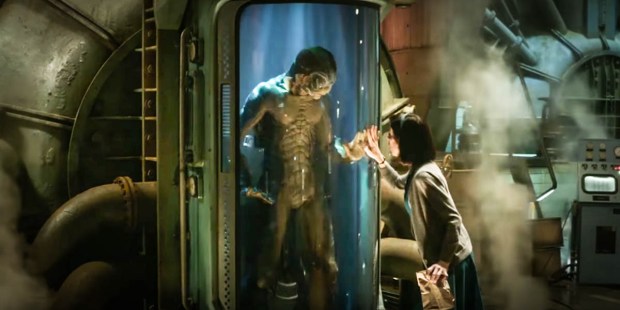The Shape of Water (2017)

Guillermo del Toro’s The Shape of Water (2017) is a cinematic masterpiece that deftly blends fantasy, romance, and political commentary into a unique and captivating narrative. This film, which won the Academy Award for Best Picture, is celebrated for its imaginative storytelling, rich visual aesthetics, and profound emotional depth. Set against the backdrop of the Cold War era, The Shape of Water explores themes of love and isolation through the lens of a fantastical story about an unlikely romance between a mute woman and a mysterious aquatic creature. This essay delves into the film’s narrative structure, thematic content, and visual style, as well as its impact and significance in contemporary cinema.
The Shape of Water is set in 1962, during the height of the Cold War, and centers on Elisa Esposito (Sally Hawkins), a mute woman who works as a janitor in a high-security government laboratory. Elisa’s life is marked by solitude and a sense of otherness, compounded by her inability to speak and her limited social interactions. Her world is one of routine until she encounters a secretive amphibious creature (Doug Jones) that has been captured and subjected to cruel experimentation by the government.

The film’s narrative unfolds as Elisa forms a deep bond with the creature, discovering that it possesses both intelligence and emotional depth. Through their interactions, a romantic relationship develops, underscoring themes of empathy and connection in the face of societal alienation. As Elisa learns more about the creature’s plight, she becomes determined to rescue it from the lab and grant it the freedom it deserves.
The narrative structure of The Shape of Water is characterized by its focus on character development and emotional resonance. The film’s storytelling is driven by Elisa’s personal journey, highlighting her transformation from a lonely, marginalized figure to a courageous and compassionate heroine. The unfolding romance between Elisa and the creature is portrayed with sensitivity and nuance, allowing the audience to engage deeply with the emotional stakes of the story.
At its core, The Shape of Water is a film about love and the desire for connection across boundaries of difference. The romance between Elisa and the creature serves as a metaphor for various forms of otherness and the human capacity for empathy and understanding. The film explores themes of isolation, acceptance, and the transformative power of love.

Elisa’s muteness is a significant symbolic element in the film. It represents her isolation from the world and the way she is often overlooked and underestimated. Her ability to communicate through sign language and her deep emotional connection with the creature highlight the idea that true understanding transcends conventional forms of communication.
The creature itself embodies the theme of the “other” and the fear of the unknown. Its captivity and mistreatment reflect societal prejudices and the destructive impact of fear and ignorance. Elisa’s willingness to see beyond the creature’s outward appearance and recognize its humanity challenges these prejudices and underscores the film’s message about the importance of compassion and acceptance.
Guillermo del Toro’s direction and the film’s visual style are instrumental in creating the rich, fantastical atmosphere of The Shape of Water. The film’s cinematography, by Dan Laustsen, is characterized by its lush, evocative visuals and careful attention to detail. The use of color, lighting, and composition contributes to the film’s dreamlike quality and enhances its emotional impact.

The color palette of the film is dominated by greens, blues, and earth tones, which create a sense of both underwater wonder and cold, clinical detachment. The contrasts between the vibrant, intimate scenes of Elisa’s apartment and the sterile, oppressive environment of the laboratory emphasize the themes of isolation and connection.
The film’s use of practical effects and makeup is also notable. Doug Jones’s performance as the amphibious creature, achieved through elaborate prosthetics and motion capture, is both visually striking and deeply expressive. The creature’s design reflects a blend of fantasy and realism, contributing to the film’s unique and otherworldly atmosphere.
The Shape of Water has garnered widespread acclaim for its originality, emotional depth, and artistic vision. The film’s success at the Academy Awards, including wins for Best Picture, Best Director, and Best Production Design, underscores its impact and resonance with audiences and critics alike.

The film’s exploration of unconventional romance and its portrayal of marginalized characters have sparked discussions about representation and inclusivity in cinema. By presenting a love story that defies societal norms and celebrates differences, The Shape of Water contributes to a broader dialogue about the power of empathy and the value of diverse perspectives.
The Shape of Water (2017) is a testament to Guillermo del Toro’s skill as a filmmaker and his ability to craft a compelling and emotionally resonant story. Through its imaginative narrative, rich thematic content, and stunning visual style, the film offers a unique and poignant exploration of love, isolation, and acceptance. The film’s success and enduring impact highlight its significance as a work of art that challenges conventional boundaries and celebrates the transformative power of human connection.
As audiences continue to engage with The Shape of Water, its legacy as a groundbreaking and heartfelt film remains a testament to the power of storytelling and the importance of embracing the extraordinary in the everyday.










